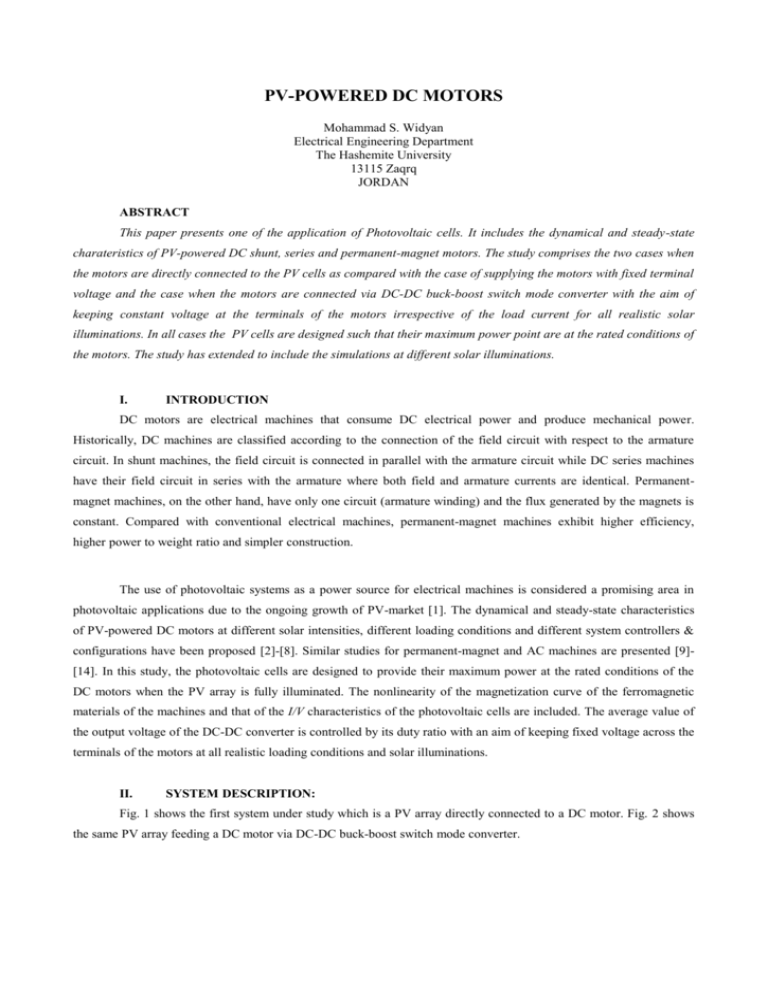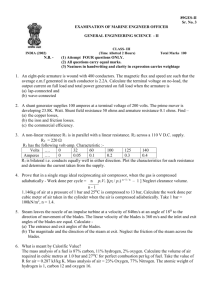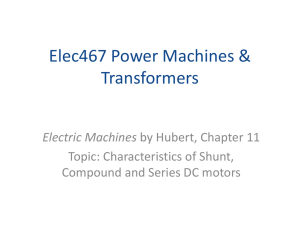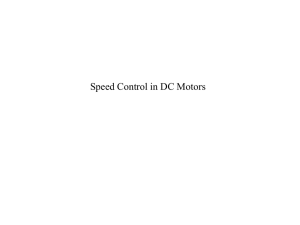PV_POWERED_DC_MOTORS_WIDYAN
advertisement

PV-POWERED DC MOTORS Mohammad S. Widyan Electrical Engineering Department The Hashemite University 13115 Zaqrq JORDAN ABSTRACT This paper presents one of the application of Photovoltaic cells. It includes the dynamical and steady-state charateristics of PV-powered DC shunt, series and permanent-magnet motors. The study comprises the two cases when the motors are directly connected to the PV cells as compared with the case of supplying the motors with fixed terminal voltage and the case when the motors are connected via DC-DC buck-boost switch mode converter with the aim of keeping constant voltage at the terminals of the motors irrespective of the load current for all realistic solar illuminations. In all cases the PV cells are designed such that their maximum power point are at the rated conditions of the motors. The study has extended to include the simulations at different solar illuminations. I. INTRODUCTION DC motors are electrical machines that consume DC electrical power and produce mechanical power. Historically, DC machines are classified according to the connection of the field circuit with respect to the armature circuit. In shunt machines, the field circuit is connected in parallel with the armature circuit while DC series machines have their field circuit in series with the armature where both field and armature currents are identical. Permanentmagnet machines, on the other hand, have only one circuit (armature winding) and the flux generated by the magnets is constant. Compared with conventional electrical machines, permanent-magnet machines exhibit higher efficiency, higher power to weight ratio and simpler construction. The use of photovoltaic systems as a power source for electrical machines is considered a promising area in photovoltaic applications due to the ongoing growth of PV-market [1]. The dynamical and steady-state characteristics of PV-powered DC motors at different solar intensities, different loading conditions and different system controllers & configurations have been proposed [2]-[8]. Similar studies for permanent-magnet and AC machines are presented [9][14]. In this study, the photovoltaic cells are designed to provide their maximum power at the rated conditions of the DC motors when the PV array is fully illuminated. The nonlinearity of the magnetization curve of the ferromagnetic materials of the machines and that of the I/V characteristics of the photovoltaic cells are included. The average value of the output voltage of the DC-DC converter is controlled by its duty ratio with an aim of keeping fixed voltage across the terminals of the motors at all realistic loading conditions and solar illuminations. II. SYSTEM DESCRIPTION: Fig. 1 shows the first system under study which is a PV array directly connected to a DC motor. Fig. 2 shows the same PV array feeding a DC motor via DC-DC buck-boost switch mode converter. Fig. 1: A photovoltaic array consisting of N s series- and N p parallel-connected modules loaded by DC motor Fig. 2: Block diagram for the system under study The circuit of the DC-DC Buck/Boost switch mode converter is: Fig. 3: Buck-boost converter circuit III. MATHEMATICAL MODEL AND CHARACTERISTICS: The dynamical model of DC shunt, series and permanent-magnet motors are presented in this section. a) DC Shunt Motor In shunt motor, the field circuit is connected in parallel with the armature. Adjustable resistor R adj is normally connected in series with the field circuit for speed control. DC shunt motor has the following dynamical model: LF La di F VT ( RF Radj )i F dt (1) dia VT Ra ia K dt (2) d Kia TL dt J where (3) LF : field winding inductance, i F : field current, VT : terminal voltage and R F Radj : total field resistance, La : armature winding inductance, i a : armature current, Ra : armature resistance, K : constant related to the design of the machine, : flux per pole, : rotational speed of the rotor, J : rotor and load moment of inertia and TL : load torque. Eqs. (1), (2) and (3) represent the nonlinear dynamical behavior of a DC shunt motor including the nonlinearity of the magnetization curve of the ferromagnetic material of the machine. b) DC Series Motor DC series motor, with its own characteristics of high starting torque which makes it suitable for high inertia as well as traction systems, has a nonlinear dynamical model. As its name indicates, the field circuit is connected in series with the armature and therefore the armature and field currents are identical. It has the following nonlinear dynamical mathematical model: ( LF La ) dia VT ( Ra RF )ia K dt J d Kia TL dt (4) (5) Eqs. (4) and (5) represent the nonlinear dynamical behavior of a DC series motor including the nonlinearity of the ferromagnetic material of the machine. c) Permanent-Magnet DC Motor Due to absence of the field current and field winding, permanent magnet machines exhibit high efficiency in operation, simple and robust structure in construction and high power to weight ratio. The attractiveness of the permanent-magnet machines is further enhanced by the availability of high-energy rare-earth permanent-magnet materials like SmCo and NdFeB [15]. However, the speed control of permanent-magnet DC motor via changing the field current is not possible. Its dynamical model can be summarized as: La dia VT Ra ia K m dt J d K m i a TL dt (6) (7) Eqs. (6) and (7) represent the dynamical model of permanent-magnet DC motor. The output charateristics of the designed PV array are given in Fig. 4 at different solar illuminations: 180 160 0.75 of Full Illumination Full Illumination 140 120 Voltage (V) 0.6 of Full Illumination 100 80 60 40 20 0 0 2 4 6 8 10 12 14 16 18 20 Current (A) Fig. 4: Output charateristics of the designed PV array at different illuminations IV. SIMULATION RESULTS 1) The case of Direct Connection with Photovoltaic Cells This section presents some dynamical and steady-state simulation results for the DC motors that are directly powered by PV cells. a) DC Shunt Motor Fig. 5 shows the armature current and motor rotational speed at different solar illuminations as compared with the case of supplying the motor by fixed terminal voltage. Fig. 6 shows the steady-state charateristics of DC shunt motor at different solar illuminations as compared with the case of supplying it by fixed terminal voltage. 16 with fixed terminal voltage 15 with photovoltaic cells at full illumination 14 with photovoltaic cells at 0.75 of full illumination Armature Current (A) 13 12 11 10 9 8 7 6 0 5 10 15 20 25 Time (Sec) (a) 30 35 40 45 50 1900 1800 with photovoltaic cells at full illumination Rotational Speed (rpm) 1700 with fixed terminal voltage 1600 1500 1400 with photovoltaic cells at 0.75 of full illumination 1300 1200 0 5 10 15 20 25 30 35 40 45 50 Time (Sec) (b) Fig. 5: (a) armature current and (b) rotational speed of DC shunt motor after a step change on the load torque from 5Nm to 10.4Nm 2000 with photovoltaic cells at full illumination with fixed terminal voltage 1800 1600 with photovoltaic cells at 0.75 illumination Rotational Speed (rpm) 1400 1200 1000 800 600 400 200 0 0 2 4 6 8 10 12 Torque (Nm) Fig. 6: Torque-speed characteristics of DC shunt motor with photovoltaic cells at different illuminations and fixed terminal voltage b) DC Series Motor Fig. 7 shows the armature current and motor rotational speed at different solar illuminations as compared with the case of supplying the motor by fixed terminal voltage. 18 with photovoltaic cells at full illumination 16 with photovoltaic cells at 0.75 illumination Armature Current (A) 14 with fixed terminal voltage 12 10 8 6 4 2 0 5 10 15 20 25 30 35 40 45 50 45 50 Time (Sec) (a) 2000 1800 1600 Rotational Speed (rpm) 1400 with photovoltaic cells at full illumination 1200 with fixed terminal voltage 1000 800 with photovoltaic cells at 0.75 illumination 600 400 200 0 0 5 10 15 20 25 30 35 40 Time (Sec) (b) Fig. 7: (a) Armature current and (b) rotational speed of the DC series motor after a step increase in the load torque from 5Nm to 17Nm c) Permanent-Magnet DC Motor Fig. 8 shows the armature current and motor rotational speed at different solar illuminations as compared with the case of supplying the motor by fixed terminal voltage. 18 with fixed terminal voltage 16 Armature Current (A) with photovoltaic cells at 0.75 of full illumination 14 with photovoltaic cells at full illumination 12 10 8 6 0 5 10 15 20 25 30 35 40 45 50 Time (Sec) (a) 2200 Rotational Speed (rpm) 2000 1800 with fixed terminal voltage with photovoltaic cells at full illumination 1600 1400 with photovoltaic cells at 0.75 illumination 1200 1000 0 5 10 15 20 25 30 35 40 45 50 Time (Sec) (b)Fig. 8: (a) Armature current and (b) rotational speed of the permanent-magnet DC motor after a step increase in the load torque from 5Nm to 11.9Nm 2) The case of Connection via DC-DC Buck/Boost Switch Mode Converter This section presents some dynamical and steady-state charateristics of DC motors powered by PV cells via DCDC Buck-Boost switch mode converter. a) DC Shunt Motor 165 Photovoltaic Cells Terminal Voltage (V) 160 155 at full illumination 150 145 140 at 0.75 of full illumination 135 130 125 0 2 4 6 8 10 12 14 12 14 16 18 20 Time (Sec) (a) Motor Terminal Voltage (Converter Terminal Voltage) (V) 125.5 at 0.75 of full illumination at full illumination 125 124.5 124 0 2 4 6 8 10 16 18 20 Time (Sec) (b) Fig. 9: Photovoltaic cells terminal voltage at full illumination and 0.75 of full illumination after step increase in the load torque from 5Nm to 10.4Nm and (b) the corresponding DC shunt motor terminal voltage 300 Line: at full illumination o: at 0.75 of full illumination 280 Rotational Speed (Rad/Sec) 260 DC Series Motor 240 220 200 Permanent-Magnet DC Motor 180 160 DC Shunt Motor 140 120 100 0 2 4 6 8 10 12 14 16 18 Load Torque (Nm) Fig. 10: Torque-speed characteristics of DC shunt, series and permanent-magnet motors fed by photovoltaic cells via DC-DC buck-boost switch mode converter at full solar illumination and 0.75 of full illumination CONCLUSIONS The dynamical and steady-state charateristics of DC shunt, series and permanent-magnet motors are presented. The case of supplying the motors directly from PV cells as compared with the case of supplying them from fixed terminal voltage is presented. Additionally, the case of powering the DC motors by PV cells via DC-DC Buck-Boost switch mode converters is addressed. REFERENCES [1] A. Al Tarabsheh, "Amorphous Silicon Based Solar Cells", Doctoral Diss., Institute of Physical Electronics, University of Stuttgart, Stuttgart, Germany, 2007. [2] V. Badescu, "Dynamic Model of a Complex System Including PV cells, Electric Battery, Electrical Motor and Water Pump", Solar Energy, Vol. 28, pp. 1165-1181, 2003. [3] W. Anis and H. M. B. Metwally, "Dynamic Performance of a Directly Coupled PV Pumping System", Solar Energy, Vol. 53, No. 3, 1994. [4] H. M. Metwally and W. R. Anis, "Dynamic Performance of Directly Coupled Photovoltaic Water Pumping System Using D.C. Shunt Motor", Energy Convers. Mgm. Vol. 37, No. 9, pp. 1407-1416, 1996. [5] H. Hilmer, A. Ratka, K. Vajen, H. Ackermann, W. Fuhs and O. Melsheirner, "Investigation of Directly Coupled Photovoltaic Pumping System Connected to a Large Absorber Filed", Solar Energy, Vol. 61, pp. 65-76, 1997. [6] M. Akbaba, I. Qamber and A. Kamal, "Matching of Separately Excited DC Motor to Photovoltaic Generators for Maximum Power Output", Solar Energy, Vol. 63, pp. 375-385, 1998. [7] M. Bello and I. Davidson, "Dynamics of Solar-Powered Fractional Horse Power Motor", Int. Conf. on Electrical and Electronics Engineering, 7-9 Sept. pp. 273-277, 2005. [8] M. Akbaba and M. C. Akbaba, "Dynamic Performance of a Photovoltaic-Boost Converter Powered DC MotorPump System", IEEE Int. Conf. Electrical Machines and Drives, pp. 356-361, 2001. [9] M. Akbaba, "Matching Induction Motors to PVG for Maximum Power Transfer", The 9 th Arab Int. Conf. Solar Energy , Vol. 209, pp. 31-38, 2007. [10] A. Betka and A. Moussi, "Performance Optimization of a Photovoltaic Induction Motor Pumping System" Renewable Energy, Vol. 29, pp. 2167-2181, 2004. [11] C. Hua, J. Lin and C. Shen, "Implementation of a DSP Controlled Photovoltaic System with Peak Power Tracking", IEEE Trans. Ind. Electronics, Vol. 45, No. 1, pp. 99-107, Feb. 1998. [12] E. Muljadi, "PV Water Pumping with a Peak Power Tracker Using a Simple Six Step Square-Wave Inverter", IEEE Trans. Industrial Applications, Vol. 33, No. 3, pp. 714-721, May/June 1997. [13] C. L. P. Swamy, B. Singh and B. P. Singh, "Dynamic Performance of a Permanent Magnet Brushless DC Motor Powered by a PV Array for Water Pumping", Solar Energy Mater, Solar Cells, Vol. 36, pp. 187-200, 1995. [14] L. D. Partain, Solar cells and their applications, John Wiley & Sons, Inc., 1995. [15] M. S. Widyan, "Design, Optimization, Construction and Test of Rare-Earth Permanent-Magnet Electrical Machines with New Topology for Wind Energy Applications", Doctoral Diss., Institute of Energy and Automation Technology, Berlin University of Technology, Germany, 2006.







